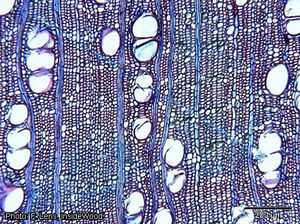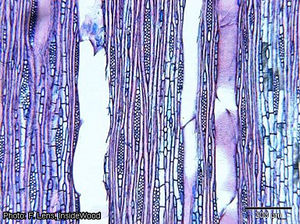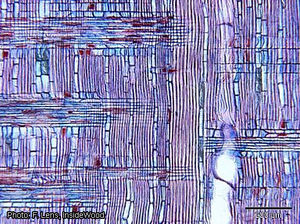Chrysophyllum giganteum (PROTA)
Introduction |
Chrysophyllum giganteum A.Chev.
- Protologue: Bull. Soc. Bot. France 61, Mém. 8: 267 (1917).
- Family: Sapotaceae
- Chromosome number: 2n = 26
Synonyms
- Gambeya gigantea (A.Chev.) Aubrév. & Pellegr. (1960),
- Gambeyobotrys gigantea (A.Chev.) Aubrév. (1972).
Vernacular names
- Koanandio, abam géant (Fr).
Origin and geographic distribution
Chrysophyllum giganteum occurs from Sierra Leone to Cameroon, Gabon and Congo.
Uses
The wood of Chrysophyllum giganteum is similar to that of Pouteria spp. and is used in the same way, e.g. for interior construction, joinery and furniture. The fruits are edible; they are sold on village markets in Ghana.
Production and international trade
The wood of Chrysophyllum giganteum enters trade together with that of Pouteria spp. as ‘aningré’, ‘aniégré’ or ‘aninguéri’. In 1972, 1973 and 1983, Côte d’Ivoire exported about 135,000 m³ of logs of ‘aniégré’ per year, mainly to Italy, Spain and Greece.
Properties
The heartwood is yellowish white, darkening to creamy pink, and indistinctly demarcated from the sapwood. The grain is straight, occasionally interlocked, texture fine to moderately fine.
The wood is medium-weight, with a density of 540–570 kg/m³ at 12% moisture content. The rates of shrinkage are moderate, from green to oven dry 3.2–4.9% radial and 6.8–8.0% tangential. With some care, the wood air dries well with little degrade. Once dry, it is stable in service.
At 12% moisture content, the modulus of rupture is 114–123 N/mm², modulus of elasticity 9410–10,100 N/mm², compression parallel to grain 44–47 N/mm², shear 5.5–7.0 N/mm², cleavage 13–14 N/mm and Chalais-Meudon hardness 2.3–2.6.
The wood is easy to saw, works well with hand and machine tools, and it can be planed to an excellent finish. Unlike Pouteria wood, it does not blunt sawteeth because it hardly contains silica. It does not easily split when nailed, and it holds nails and screws well. It has good gluing and painting properties, and peels and slices satisfactorily. The wood is not durable and liable to attack by fungi and termites. However, it is not very susceptible to Lyctus attack. It can be treated with preservatives using pressure processes.
Description
- Medium-sized to fairly large tree up to 35 m tall; bole up to 90 cm in diameter, straight, sometimes fluted, reaching up to 20 m to the first branches, with steep buttresses at base; bark thick, surface greyish white, longitudinally fissured, exuding a sticky latex when cut; crown dense; young branches greyish brown to reddish brown appressed hairy.
- Leaves arranged spirally in tufts at the ends of branches, simple and entire; stipules absent; petiole c. 1 cm long; blade obovate-oblong, 8–20 cm × 3–7 cm, cuneate at base, shortly acuminate at apex, leathery, silvery to reddish brown appressed hairy below, with small translucent dots above, pinnately veined with 7–10 pairs of lateral veins. Inflorescence an axillary false raceme c. 3 cm long, densely hairy.
- Flowers bisexual, regular, 5-merous; pedicel 3–4 mm long; sepals free, c. 1.5 mm long, pubescent outside; corolla c. 2 mm long, with short lobes, glabrous, creamy white; stamens inserted in corolla tube, opposite corolla lobes; ovary superior, conical, long-hairy, 5-celled, style short.
- Fruit a globose berry up to 5.5 cm in diameter, becoming yellow-orange and glabrous when ripe, up to 5-seeded.
- Seeds ellipsoid, flattened, up to 3 cm × 2 cm × 1 cm, brown, with large scar.
- Seedling with epigeal germination.
Other botanical information
Fruits are produced in the drier months of the year; the seeds are dispersed by monkeys and other animals that relish the fruits.
Chrysophyllum comprises about 70 species and occurs throughout the tropics. Tropical America is richest in species (about 45), followed by continental Africa (about 15), Madagascar (about 10) and tropical Asia and Australia (together 2). The genus has been subdivided into 6 sections, 2 of which (sect. Aneuchrysophyllum and sect. Donella) contain African species. Chrysophyllum giganteum belongs to sect. Aneuchrysophyllum. It resembles Chrysophyllum albidum G.Don, which has similar wood but is more important as a fruit tree and which differs in its fascicled flowers.
Ecology
In Côte d’Ivoire and Ghana Chrysophyllum giganteum occurs in semi-deciduous forest, where it is common. In Cameroon and Gabon it seems to be much less common.
Management
The 1000-seed weight is about 1 kg.
Genetic resources
In West Africa Chrysophyllum giganteum is common in semi-deciduous forest, and although it is commonly exploited for its timber, it does not yet seem to be under threat of genetic erosion.
Prospects
The exploitation of Chrysophyllum giganteum seems to take place on a larger scale; it is probably logged indiscriminately together with Pouteria spp. Research is needed on growth and natural propagation to develop methods of sustainable management of forests where it occurs.
Major references
- Aubréville, A., 1959. La flore forestière de la Côte d’Ivoire. Deuxième édition révisée. Tome troisième. Publication No 15. Centre Technique Forestier Tropical, Nogent-sur-Marne, France. 334 pp.
- Aubréville, A., 1972. Gambeyobotrys, genre nouveau de Sapotacées. Adansonia, séries 2, 12(2): 187–189.
- Normand, D., 1970. Les aniégré, Sapotacées de Côte d’Ivoire et leurs bois. Bois et Forêts des Tropiques 134: 3–13.
- Takahashi, A., 1978. Compilation of data on the mechanical properties of foreign woods (part 3) Africa. Shimane University, Matsue, Japan, 248 pp.
Other references
- ATIBT (Association Technique Internationale des Bois Tropicaux), 1986. Tropical timber atlas: Part 1 – Africa. ATIBT, Paris, France. 208 pp.
- Aubréville, A., 1964. Sapotacées. Flore du Cameroun. Volume 2. Muséum National d’Histoire Naturelle, Paris, France. 143 pp.
- Burkill, H.M., 2000. The useful plants of West Tropical Africa. 2nd Edition. Volume 5, Families S–Z, Addenda. Royal Botanic Gardens, Kew, Richmond, United Kingdom. 686 pp.
- de la Mensbruge, G., 1966. La germination et les plantules des essences arborées de la forêt dense humide de la Côte d’Ivoire. Centre Technique Forestier Tropical, Nogent-sur-Marne, France. 389 pp.
- Durand, P., 1983. Aniégrés et longhis: étude comparative de leurs propriétés technologiques. Centre Technique Forestier Tropical, Abidjan, Côte d’Ivoire. 29 pp.
- Hawthorne, W.D., 1995. Ecological profiles of Ghanaian forest trees. Tropical Forestry Papers 29. Oxford Forestry Institute, Department of Plant Sciences, University of Oxford, United Kingdom. 345 pp.
- Hawthorne, W., 1990. Field guide to the forest trees of Ghana. Natural Resources Institute, for the Overseas Development Administration, London, United Kingdom. 275 pp.
- Savill, P.S. & Fox, J.E.D., 1967. Trees of Sierra Leone. Forest Department, Freetown, Sierra Leone. 316 pp.
- Siepel, A., Poorter, L. & Hawthorne, W.D., 2004. Ecological profiles of large timber species. In: Poorter, L., Bongers, F., Kouamé, F.N. & Hawthorne, W.D. (Editors). Biodiversity of West African forests. An ecological atlas of woody plant species. CABI Publishing, CAB International, Wallingford, United Kingdom. pp. 391–445.
Author(s)
- R.H.M.J. Lemmens, PROTA Network Office Europe, Wageningen University, P.O. Box 341, 6700 AH Wageningen, Netherlands
Correct citation of this article
Lemmens, R.H.M.J., 2007. Chrysophyllum giganteum A.Chev. In: Louppe, D., Oteng-Amoako, A.A. & Brink, M. (Editors). PROTA (Plant Resources of Tropical Africa / Ressources végétales de l’Afrique tropicale), Wageningen, Netherlands. Accessed 31 March 2025.
- See the Prota4U database.




